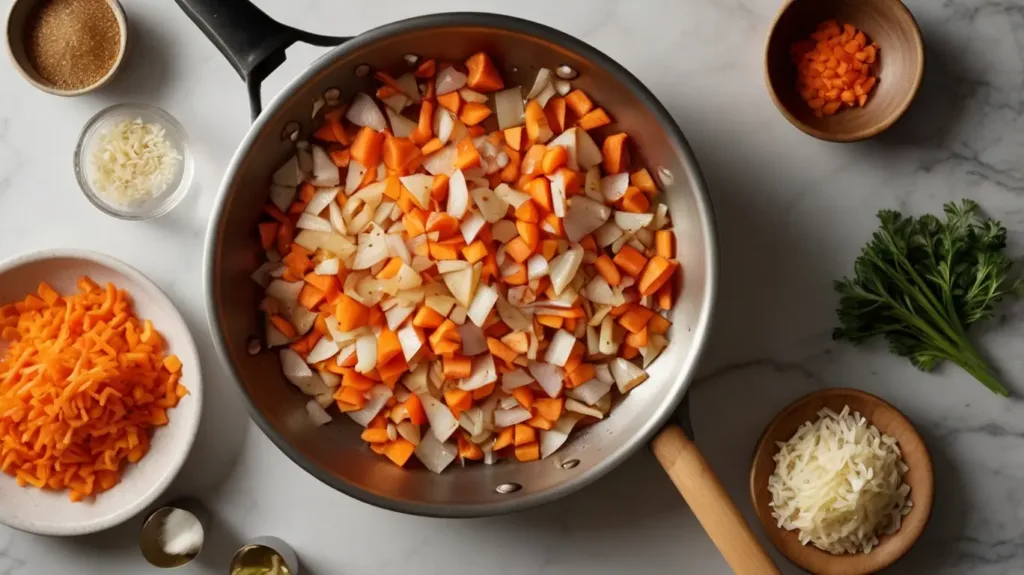The Magic of Soups: Comfort in a Bowl
Soup has always been a staple of comfort, filling homes with warmth and inviting aromas. Whether it’s a classic chicken noodle soup on a cold winter evening or a refreshing gazpacho in the summer, soups hold a special place in the heart of many kitchens. But what if you could take your soup to the next level? Adding a secret ingredient for soup can transform your dish, making it more flavorful and satisfying. Soups bring people together, offering nourishment and satisfaction in every spoonful. The magic of soups is that they can be whatever you need them to be—comfort food, a healthy meal, or a culinary adventure.
What Makes a Soup Truly Exceptional?
Great soups don’t just happen by accident; they are crafted with care. From the base stock to the final garnish, every element contributes to creating an exceptional dish. Discover a one ingredient upgrade for better soup that can take your recipe to the next level. The texture, depth of flavor, and balance all play critical roles. But what sets the best soups apart is their ability to surprise your taste buds with layers of complexity.
The Role of a Secret Ingredient in Soup Perfection
One of the most exciting ways to elevate your soup game is by adding a secret ingredient. It could be something as simple as a splash of acid or a sprinkle of spice, but its impact is transformative. This ingredient not only enhances the overall flavor but also ties all the components together, making each bite more satisfying.
Why Everyone Should Know This Cooking Secret
Knowing how to elevate your soup with a single, well-chosen ingredient is a game-changer for home cooks. It’s not about complicating your recipe but rather about unlocking its full potential. This knowledge empowers you to turn even the simplest soups into something memorable, ensuring every meal is a hit.
A Brief History of Culinary Enhancements in Soups
Soup has been a cornerstone of culinary history for centuries, evolving alongside human taste and innovation.
The Origins of Flavor-Building Techniques
Ancient civilizations began experimenting with spices and herbs to enhance basic broths. These early techniques laid the groundwork for the rich and diverse soups we enjoy today.
Evolution of Ingredients in Home Cooking
As global trade expanded, home cooks gained access to new ingredients. This revolutionized the way soups were made, introducing exotic flavors and inspiring creativity in kitchens around the world.
Discovering the Secret Ingredient
Creating the perfect soup isn’t just about following a recipe; it’s about understanding the delicate art of flavor balancing. The secret ingredient we’ll explore isn’t just a gimmick—it’s a transformative addition that can take your soup from ordinary to extraordinary.
The Importance of Flavor Balancing
Flavor balancing is the key to a memorable dish. It’s the process of combining salty, sweet, sour, and umami elements in harmony. When a soup lacks balance, it feels flat or overpowering. Adding the right ingredient can bridge the gap, enhancing the other flavors without overwhelming them. For instance, a touch of acidity can brighten a soup, while a dash of sweetness can soften harsh tones. This balance keeps every bite enjoyable and leaves you craving more.
What Is the Most Important Ingredient in Soup?
You might think it’s the broth or the protein that defines a soup, but the true star often lies in the smallest detail. While a quality stock provides a foundation and fresh vegetables add texture, it’s the unexpected ingredient—like a splash of vinegar, a hint of miso, or even a pinch of sugar—that truly elevates the dish. These additions work like magic, amplifying flavors and creating depth.
Why Do Chefs Add Vinegar and Other Acids?
Professional chefs often reach for vinegar, citrus, or other acids to give their soups a distinctive edge. The acidity helps cut through rich flavors, adding brightness and making the dish feel lighter.
The Science Behind Acid in Soup Flavor
Acids work by enhancing the natural flavors of the ingredients. They stimulate your taste buds, making every element in the soup pop. Without them, even well-seasoned soups can taste dull or one-dimensional.
Popular Acids and Their Roles in Soups
From balsamic vinegar for a sweet tang to lemon juice for a citrusy kick, acids come in many forms. Each type adds a unique character, allowing you to customize your soup’s flavor profile.
The Ultimate Secret Ingredient Revealed
So, what is the ultimate secret ingredient for taking your soup to the next level? Surprisingly, it’s fish sauce! Although it may seem unconventional at first, just a few drops of this umami-packed liquid can work wonders. In fact, fish sauce doesn’t make your soup taste fishy; instead, it subtly enhances the other flavors, adding both depth and complexity.
How This Ingredient Enhances Every Bowl
Fish sauce is rich in glutamates, which are compounds that create umami—a savory flavor that lingers on your palate. This makes your soup more satisfying, turning a simple recipe into a restaurant-quality dish.
Pairing It with Other Soup Ingredients
The beauty of fish sauce is its versatility. It pairs beautifully with chicken, beef, or vegetable-based soups. Just a teaspoon can transform a classic tomato soup or add depth to a hearty lentil stew.
Alternatives to Experiment With
If fish sauce isn’t for you, don’t worry! There are plenty of other options to explore.
Affordable and Readily Available Options
Soy sauce, Worcestershire sauce, or even nutritional yeast can mimic the umami effect of fish sauce. These pantry staples are easy to find and can be used in similar ways.
Tips for Sourcing High-Quality Ingredients
For the best results, choose high-quality fish sauce or its alternatives. Look for products with minimal additives and natural fermentation processes. A good rule of thumb is to opt for brands that list fish and salt as the main ingredients.
Techniques & Applications
Now that you know the secret ingredient, the next step is learning how to incorporate it seamlessly into your soups. Mastering techniques and avoiding common pitfalls will ensure your dishes are consistently delicious.
Unlocking Flavors with Cooking Techniques

Great cooking is as much about technique as it is about ingredients. The way you prepare your soup can significantly influence its final flavor and texture. For example, slow simmering helps extract maximum flavor from bones, vegetables, or legumes, while sautéing aromatics like onions and garlic before adding liquid builds a rich base. Using the secret ingredient at just the right moment amplifies these effects.
How to Incorporate the Secret Ingredient Seamlessly

The key to incorporating fish sauce or its alternatives is moderation. Start with a small amount—typically a teaspoon for a medium pot of soup—and adjust to taste. Add it during the final stages of cooking to preserve its delicate umami properties. This allows the ingredient to blend naturally without overpowering the other flavors.
Mistakes to Avoid When Using the Secret Ingredient
Even a great ingredient can go wrong if not used properly. Avoid these common mistakes to ensure your soup turns out perfect every time.
Balancing Flavors Without Overpowering the Dish
Adding too much fish sauce can make your soup taste salty or overly pungent. Always taste as you go and complement it with other seasonings like lime juice or sugar for balance.
Avoiding Common Soup-Cooking Pitfalls
Don’t skip key steps like deglazing your pan or using fresh ingredients. These small actions make a big difference in the final flavor. Also, resist the urge to boil soups aggressively, as this can muddy flavors and compromise texture.
Recipes Featuring the Secret Ingredient
Now, let’s dive into some recipes that showcase the secret ingredient, transforming classic soups into extraordinary dishes.
Classic Vegetable Soup with a Flavor Twist

Take your favorite vegetable soup recipe and add a teaspoon of fish sauce during the last five minutes of cooking. This simple addition brings out the natural sweetness of the vegetables while adding depth.
Hearty Lentil Soup with a Secret Kick
Combine red lentils, carrots, and cumin in a rich broth. Stir in fish sauce just before serving, and garnish with fresh parsley. The result is a comforting bowl with layers of flavor.
Creamy Tomato Soup Reimagined
Elevate creamy tomato soup by sautéing onions and garlic in olive oil, then blending with roasted tomatoes and cream. A dash of fish sauce ties the sweetness of the tomatoes and the creaminess of the soup together, making it irresistible.
Preserving Leftovers: Tips for Freezing Soups

If you have leftover soup, proper storage is essential to maintain its flavor and freshness.
How to Maintain Flavor When Reheating Soups
Freeze soup in airtight containers, leaving some space for expansion. When reheating, add a splash of water or broth to restore consistency and a fresh dash of the secret ingredient to revive the flavors.
Nutritional Insights & FAQs
Soups are not just delicious—they’re often packed with nutrients that can contribute to a healthy, balanced diet. The secret ingredient we’ve revealed also brings nutritional benefits that might surprise you.
The Nutritional Benefits of a Balanced Soup
A well-crafted soup provides an array of vitamins, minerals, and macronutrients in every bowl. From protein-rich lentils to vitamin-packed vegetables, soups are an easy way to meet your daily nutritional needs. Additionally, broths made from bones are high in collagen, which supports joint and skin health. Adding the secret ingredient, such as fish sauce, enhances these benefits by providing essential amino acids.
Why the Secret Ingredient Boosts Nutrition
Fish sauce, made from fermented fish, is rich in natural nutrients. It contains protein, omega-3 fatty acids, and a variety of vitamins and minerals. Its umami flavor allows you to use less salt while still delivering a satisfying taste, making your soups both flavorful and heart-healthy.
Low-Calorie and High-Flavor Options
Soups are a fantastic way to enjoy a filling meal without consuming too many calories. By focusing on broth-based soups with vegetables and lean proteins, you can create dishes that are low in calories but high in nutrients. Adding a small amount of the secret ingredient boosts flavor without adding significant calories.
How to Modify for Vegan and Gluten-Free Diets
The secret ingredient is naturally gluten-free, but for a vegan alternative, try soy sauce or coconut aminos. These substitutes provide a similar umami effect and work wonderfully in vegetable-based soups. Simply swap traditional broths for vegetable stock to make your soup vegan-friendly.
FAQs About Secret Ingredient for Soup
What Gives Soup the Best Flavor?
The best soups achieve balance between their components—aromatics, seasoning, and broth. The secret ingredient ties these flavors together, adding depth and richness.
Can I Substitute the Secret Ingredient?
Yes! If fish sauce isn’t your preference, soy sauce, tamari, or even a bit of Worcestershire sauce can work as substitutes. Adjust the amount to achieve the desired flavor.
What’s the Secret to a Good Soup?
Layering flavors is the key. Start with a strong base, such as a well-made stock, and add ingredients in stages. Don’t forget the finishing touch—just a teaspoon of the secret ingredient can make all the difference.
Why Do Chefs Put Vinegar in Soup?
Vinegar and other acids brighten the flavor of soups, balancing richness and enhancing the natural taste of the ingredients.
Can This Recipe Be Made Ahead and Frozen?
Absolutely! Most soups freeze well and reheat beautifully. Just store them in airtight containers and reheat gently, adding a splash of broth or water if needed.
What Are the Best Herbs and Spices for Soup?
Herbs like thyme, parsley, and cilantro are excellent for freshening up soups, while spices like cumin, paprika, and turmeric add warmth and depth. Experiment to find your favorite combinations.
How Can I Fix an Overly Salty or Acidic Soup?
To fix overly salty soup, add a starchy ingredient like a potato or more liquid to dilute the salt. If it’s too acidic, a pinch of sugar can help balance the flavor.

